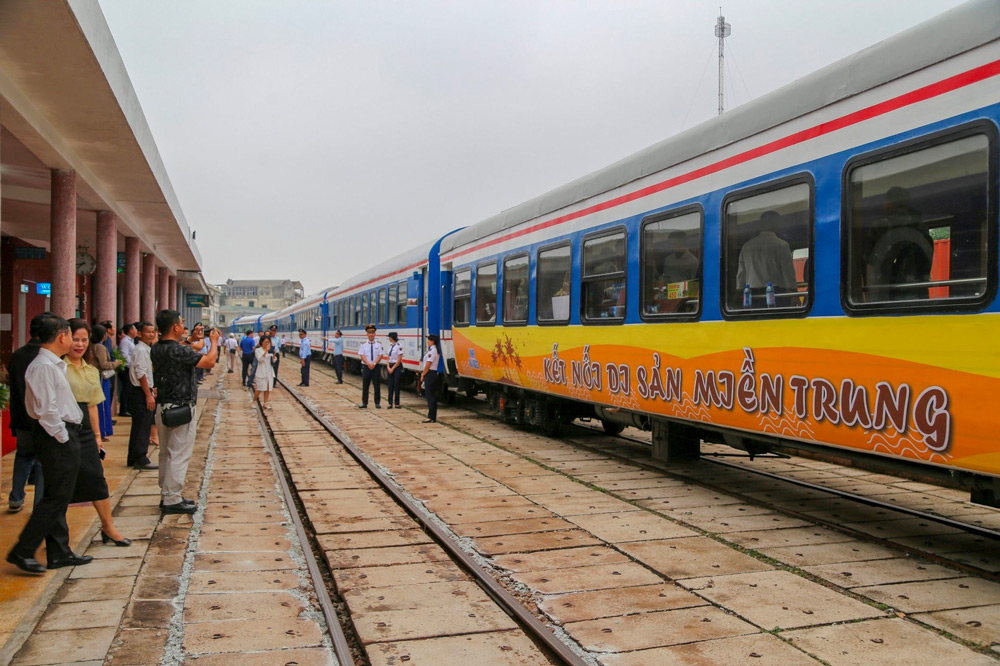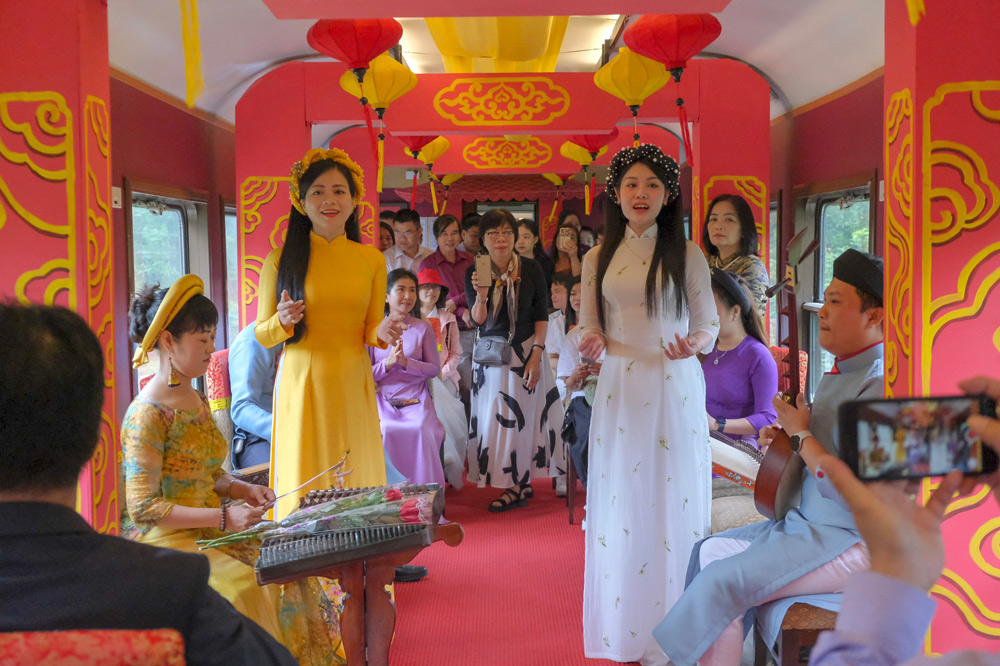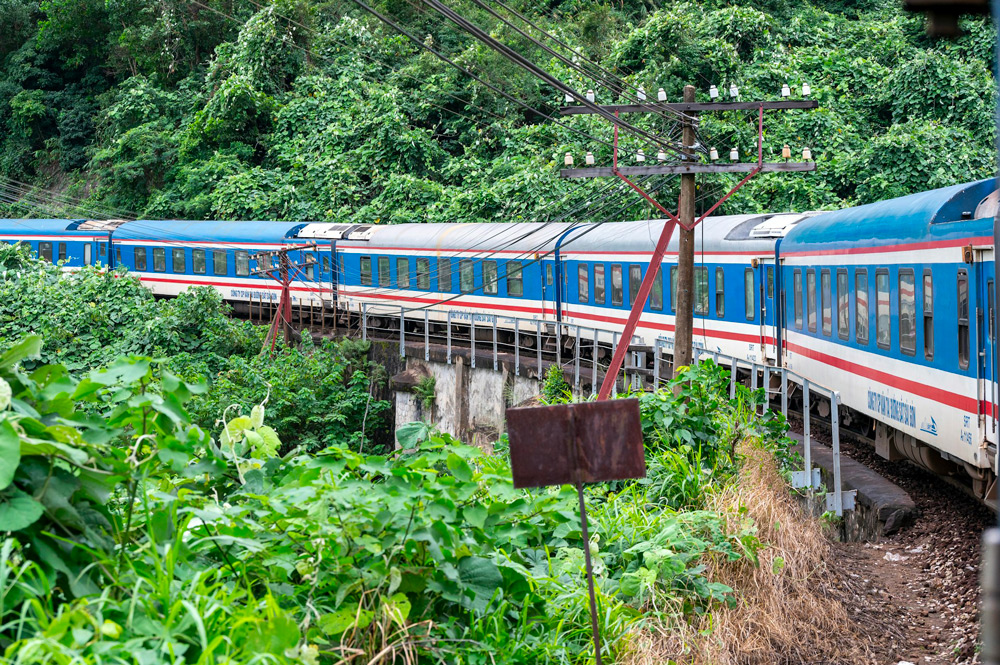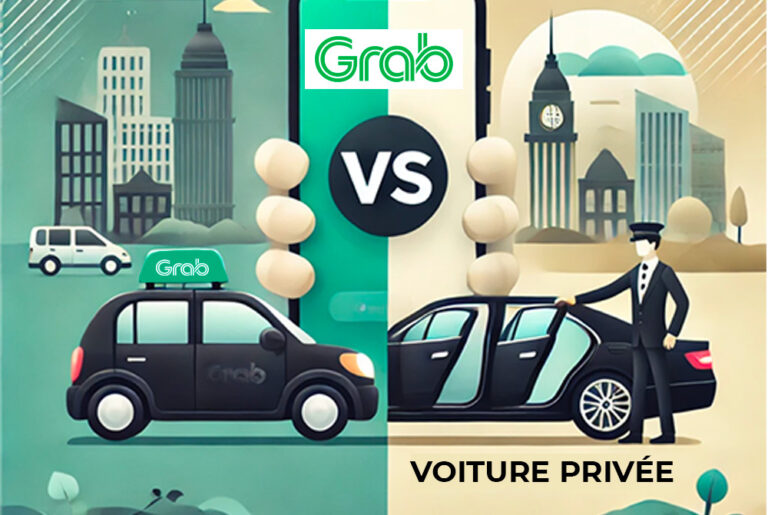Tourist Train Between Hué and Da Nang | Is It Worth It?
If you’ve ever traveled between Hué and Da Nang, you know that transportation options are plentiful: bus, motorbike, regular train, private car… But let’s be honest, after a few trips back and forth, it quickly feels like just another journey, a routine transfer between two destinations.
So, I wanted to try the Connecting Central Heritage tourist train, which was launched on March 26, 2024. A train promising a unique experience, featuring a buffet of local specialties, traditional music, and most importantly, a breathtaking view of the Hải Vân Pass. Sounds tempting, right?
So, is it really worth it? Is this a hidden gem or just a well-packaged tourist trap? I tested it for you, and here’s my honest take.
What Is the Connecting Central Heritage Train?

The Connecting Central Heritage isn’t just another train between Hué and Da Nang-it aims to enhance the travel experience for tourists. Unlike regular trains, where you simply watch the scenery pass by, this one is designed to make the journey itself part of the adventure.
The idea? To offer a cultural immersion throughout the trip, with local cuisine, live traditional music, and of course, one of the most scenic railway routes in Vietnam. In short, it’s a way to travel more peacefully, taking time to admire the coastline, lush jungle, and mountains while enjoying a more comfortable ride.
And let’s be real-taking the train in Vietnam is often an adventure. But here, you’re far from the crowded carriages and chaotic journeys. The experience is more premium, more relaxed, and clearly designed for those who want to enjoy the journey as much as the destination.
Tourist Train vs. Regular Train
As soon as I stepped aboard the Connecting Central Heritage, I could immediately tell that an effort had been made. Here, no hard seats or overcrowded carriages where you have to elbow your way to a spot.
So, what really sets the tourist train apart from the regular train?
1. Live Music

One of the highlights of this train is the live traditional Vietnamese music performed by artists dressed in ao dai alongside musicians. The atmosphere is pleasant without being overwhelming, adding a unique cultural touch to the journey.
This live performance aspect really enhances the experience. Personally, it was my favorite part of this new tourist train.
2. Local Flavors Buffet

Because traveling is also about discovering local cuisine, the tourist train from Hué to Da Nang offers a buffet featuring regional specialties. So, what’s on the menu?
You’ll find Central Vietnam’s signature dishes:
- Bánh nậm & bánh bèo – Small rice flour cakes, a Hué specialty, served with nước mắm (fish sauce).
- Bún bò Huế – The famous spicy beef noodle soup with lemongrass.
- Local desserts – Often based on sticky rice and coconut milk.
Honestly, for a tourist train, the quality is decent but not extraordinary. It’s not a gourmet feast, but you can tell there was at least some effort to offer local dishes.
Important note: The buffet is not included in the ticket price. I would have loved to see at least one specialty dish included in the fare.
3. More Comfortable Than a Regular Train

When it comes to comfort, this train is far ahead of the aging carriages of standard trains. The seats are spacious, well-spaced, and the large windows offer a great view with minimal effort.
There are also power outlets and WiFi, but don’t expect much-the connection is terrible, especially at the Hải Vân Pass.
Clearly, it’s a huge step up from regular train or bus journeys.
4. Stop at Lang Co Station


I’d definitely put this 10-minute stop in the “useless” category.
It’s neither well-thought-out nor enjoyable. There’s nothing to see, and the view is disappointing. I have no idea whether another train passes at that time or if they just added this stop for no reason, but honestly, it’s a waste of time.
How to Book and How Much Does It Cost?
If you’re tempted by this experience, here’s how to book your ticket for the Connecting Central Heritage and what to expect in terms of pricing.
Where and How to Buy Your Ticket?
Good news! The tourist trains (HD1, HD2, HD3, and HD4) are available on most specialized booking websites. You can reserve your ticket:
- Online through official platforms or agencies like Bao Lau ( a trusted platform to book trains, buses, and flights in Vietnam ).
- At the train stations in Hué or Da Nang, if you prefer to book in person.
- Via your hotel, as some accommodations offer booking services for their guests.
Pro tip: During peak season, this train is quite popular, so it’s best to book in advance, especially if you want to grab a good seat for the scenic views.
Schedule and Frequency of Departures
The Connecting Central Heritage is not a regularly running train like the classic ones. It follows a specific schedule with a limited number of departures per week.
There are two trips per day in each direction, totaling four trips daily. Checking the schedule in advance is crucial to avoid showing up at the station only to realize you have to take a standard train instead.
| Train | Départ | Arrivée | Heure de départ | Heure d’arrivée | Durée | Prix (VND) |
|---|---|---|---|---|---|---|
| HD1 | Hué | Da Nang | 07h35 | 10h30 | 2h55 | 180,000₫ |
| HD3 | Hué | Da Nang | 14h25 | 18h00 | 3h35 | 180,000₫ |
| HD2 | Da Nang | Hué | 07h50 | 11h10 | 3h20 | 180,000₫ |
| HD4 | Da Nang | Hué | 14h50 | 17h50 | 3h00 | 180,000₫ |
Ticket Price for the Hué – Da Nang Tourist Train
Compared to the standard Hué – Da Nang train fares, which range from 80,000 to 90,000 VND, the tourist train costs 180,000 VND per person.
Is It Worth the Price? It all depends on what you’re looking for. If your goal is simply to get from Hué to Da Nang for the lowest price, then the regular trains will do just fine. But if you’re after a more comfortable journey, a pleasant atmosphere, and a chance to experience local cuisine, then this train might be worth the investment.
So, while it’s not the cheapest option, it does offer a unique travel experience with a touch of culture and comfort-a nice balance between practicality and immersion.
Best Seat for the Best View
- From Da Nang, sit on the right side.
- From Hué, sit on the left side.
Why? At the Hai Van Pass, this ensures you get a panoramic view of the sea on one side and the Lap An Lagoon on the other-a must-see!
Pros and Cons of the Hué – Da Nang Train

Like any tourist experience, this train has its strengths and limitations. So, is it really a good alternative for traveling between Hué and Da Nang? Here’s an honest breakdown.
What I Liked:
- Breathtaking landscapes: You get to fully enjoy the Hải Vân Pass, Lang Co, and Lap An Lagoon.
- A relaxed and immersive atmosphere: No stress, no honking-just the pleasure of the journey, enhanced by live music.
- Buffet with local specialties: A much better option than a basic train restaurant with industrial snacks.
- Much more comfortable than regular trains: Spacious seats, plenty of room, and great panoramic views.
What I Didn’t Like:
- More expensive than a regular train: You’re clearly paying for the experience, not just the transport.
- Limited schedule: Unlike regular trains, which run throughout the day, this one has a restricted timetable. If you miss it, you’ll need to find another way to travel.
- Not the fastest option: If you’re in a hurry, it’s better to take a bus or a private car. This train is about slow travel, taking the time to appreciate the journey.
- Pointless 10-minute stop at Lang Co Station: There’s literally nothing to see there.
- 10-minute stop at Hải Vân Pass: Just to let another train pass.
- Only one carriage with the buffet and live music: It can get crowded at the start of the trip.
My Opinion
So, after testing the Connecting Central Heritage, do I recommend it? Yes… but not for everyone.
If you’re a tourist passing through and want to enjoy a unique journey, this is a great option. You’ll get stunning coastal views, a decent buffet, some traditional music, and overall, a much nicer experience than taking a regular train or bus.
If you’re an expat living in the area and have already done this route several times, it depends. If you’re just looking for a practical way to get from Hué to Da Nang, a regular train or motorbike will do just fine. But if you’re in the mood for a more relaxed, immersive trip, then why not give it a try?






